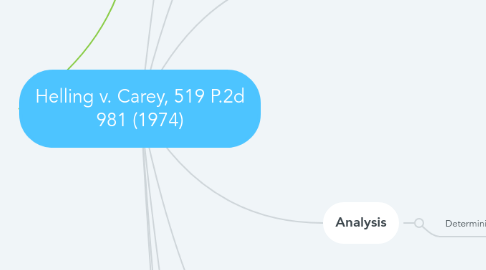
1. Can a physician be liable for damage even if he follows the standard of care?
2. Facts
2.1. Parties
2.1.1. Barbara Helling, Plaintiff
2.1.2. Thomas Carey, Robert Laughlin Defendants
2.2. What happened
2.2.1. Plaintiff (age 23 at first visit in 1959) first came to defendant for treatment presenting with myopia, nearsightedness.
2.2.1.1. defendants treated the patient with contacts
2.2.2. 9 additional visits concerning irritation related to the contact lenses through till 1968
2.2.2.1. all symptoms were attributed to issues with the contacts
2.2.2.2. standard of care did not include conducting a pressure test as glaucoma is extremely rare in patients under 40
2.2.3. In October 1968, a pressure, and FOV test was conducted, establishing the presence of glaucoma
2.2.3.1. Patient had lost peripheral vision, and had a reduction in central vision
2.2.3.2. It was concluded that the plaintiff had the condition for approximately 10 years
2.3. Procedural History
2.3.1. After consulting other physicians, plaintiff filed suit for negligence malpractice
2.3.1.1. The patient claimed damage as a proximate result of physicians failure to diagnose glaucoma
2.3.1.1.1. For a malpractice to have occurred, the plaintiff would have to prove duty of care, breach of duty, breach, injury and causation
2.3.2. Expert testimony established that the pressure test for glaucoma was not standard of care for patients under 40 years old due to the rarity of glaucoma in this age group
2.3.2.1. It was however noted that the pressure test should be conducted if sufficient evidence is presented and if the clinician feels it may be appropriate
2.3.2.1.1. The pressure test is a very simple, inexpensive and harmless procedure for a patient
2.3.3. Jury found with the defendants on the ground that the physicians adhered to standards of care which did not require the giving of the pressure test to patients under 40
3. Issue before the Court
3.1. Whether a the defendants compliance with the standard of care insulated them from the liability of the damage which resulted from failing to perform a pressure test
3.1.1. Patient had lost a substantial proportion of her vision, presented with symptoms that justified further testing
3.1.2. the test for glaucoma is inexpensive, painless, and simple procedure
4. Rule of Law
4.1. standard of care
4.1.1. Did the physician follow the standard of care for the patient? would any reasonable clinician behave in a similar manner.
4.1.1.1. standards of care did not call for testing for glaucoma for patients under 40 due to rarity of the disease in this age group
4.1.1.2. However, the patient presented with sufficient indication for testing for pressure and FOV, to diagnose glaucoma that the physician should have conducted additional tests
5. Analysis
5.1. Determining malpractice must establish
5.1.1. Duty of care
5.1.1.1. established, plaintiff was a patient of the defendants for 10 years
5.1.2. Breach of Duty
5.1.2.1. defendants argument
5.1.2.1.1. testimony of expert witnesses on both sides confirmed that it was not within the standard of care for the physicians to conduct a pressure test on a patient of the defendants age, and thus they would not be expected to perform this test which would have discovered the glaucoma sooner
5.1.2.2. Court's analysis
5.1.2.2.1. The defendants adherence to the standards of care does not insulate them from the liability of damages resulting in failing to perform the pressure test, subsequently diagnosing and treating the glaucoma in a timely manner
5.1.3. Injury
5.1.3.1. established, loss of vision
5.1.4. causation
5.1.4.1. loss of vision resulted from undiagnosed, untreated glaucoma
6. Conclusion
6.1. Overturned previous ruling, ruled in favor of Helling
7. Impact
7.1. Harris v. Groth (Wash. 1983)
7.1.1. Plaintiff complaining of eye issues sought treatment from defendant. a multitude of treatments was attempted without success
7.1.1.1. plaintiff also sought treatment with one of plaintiff's colleagues with similar results
7.1.1.2. an acute event resulted in the patient going to the ER where she was diagnosed with glaucoma
7.1.1.3. plaintiff sued plaintiff for malpractice
7.1.1.3.1. plaintiff claimed that defendant never tested for glaucoma despite indications
7.2. Hall v. Hilbun, 466 So. 2d 856 (Miss. 1985)
7.2.1. Patient expired from cardio-respiratory failure post op from a GI procedure. family sued the surgeon for providing inadequate care after the operation.
7.2.1.1. Expert testimony called by the plaintiff stated that the defendant did not adhere to national standards of care
7.2.1.2. defendant successfully argued that the expert witnesses could not speak to local standards of care, and was able to get much of expert testimony dismissed
7.2.1.3. court ruled in favor of the defense
7.2.1.3.1. plaintiff appealed
8. Importance
8.1. Clinicians can no longer rely on legacy standard of care laws,
8.1.1. Physicians must keep up with the latest developments for diagnosis and treatment

